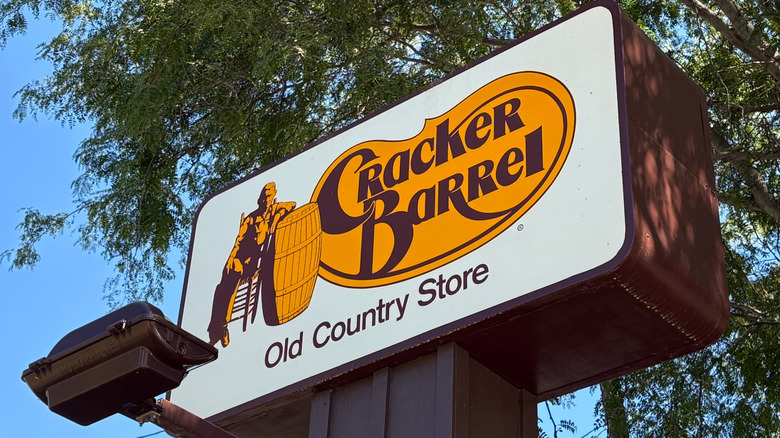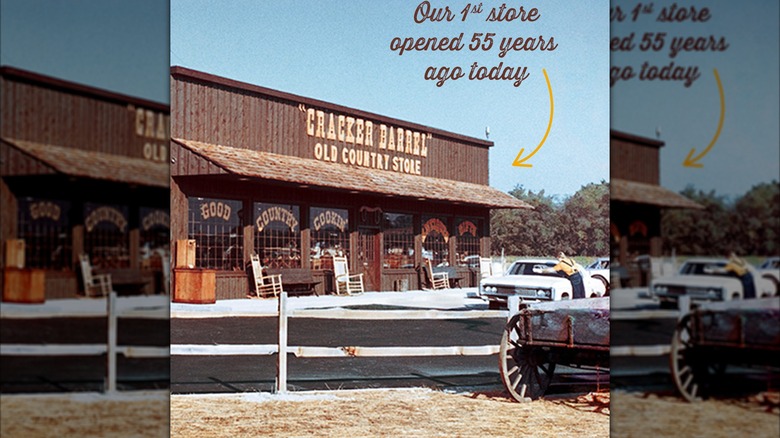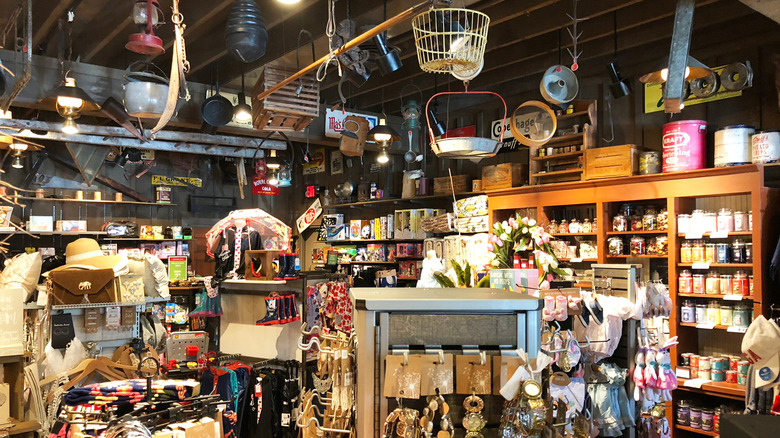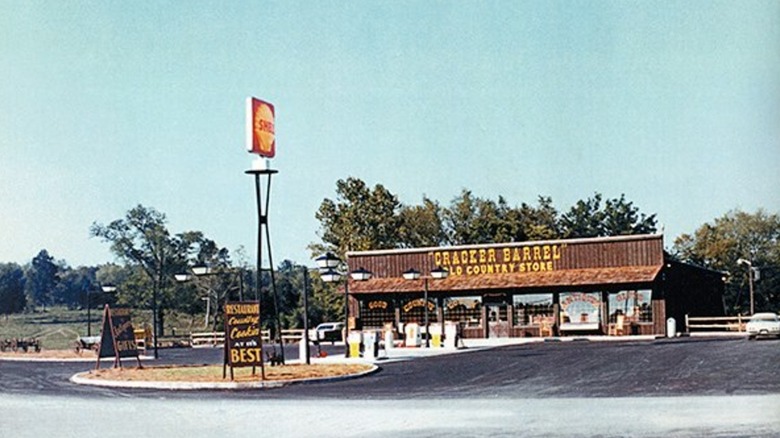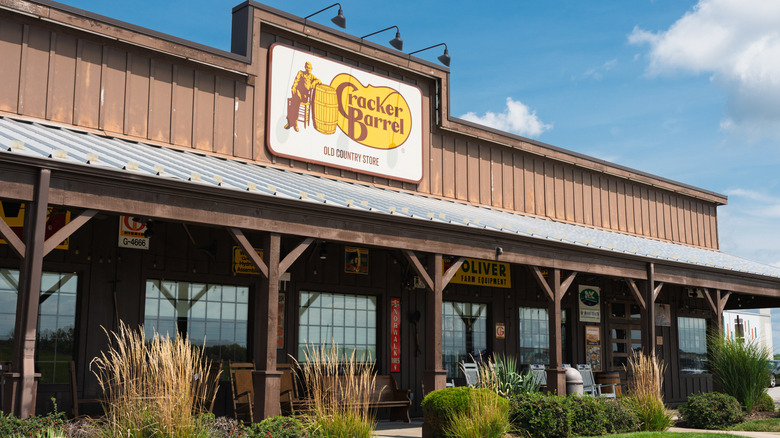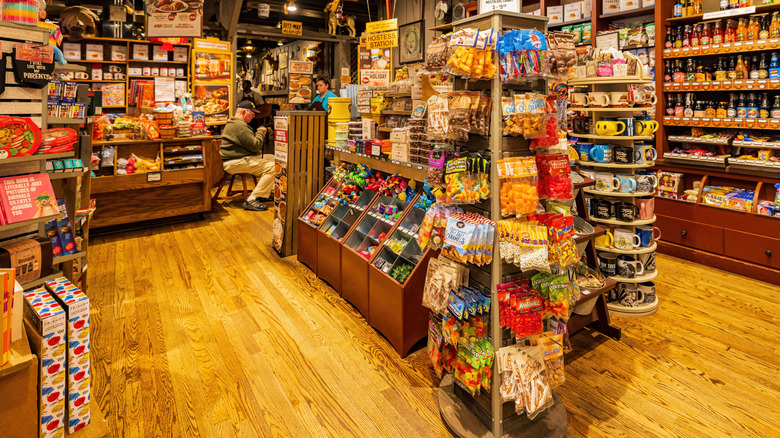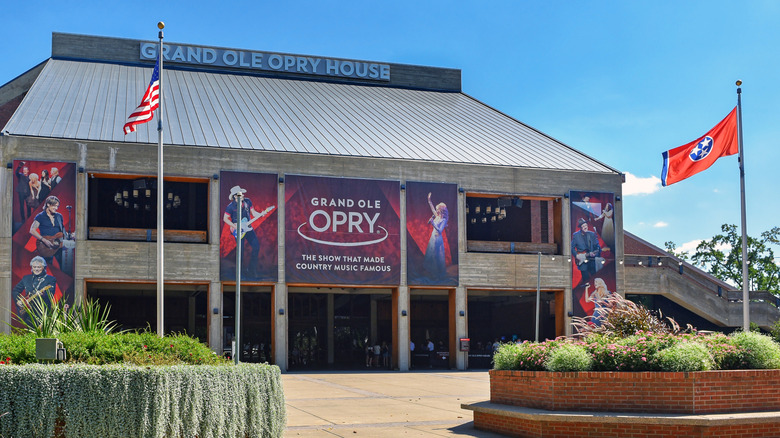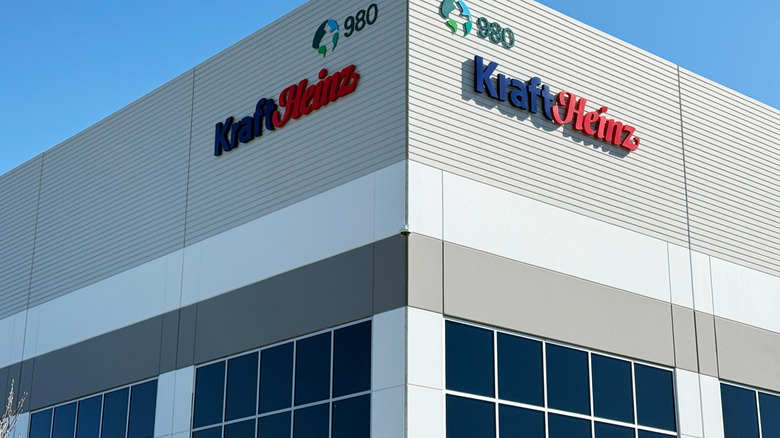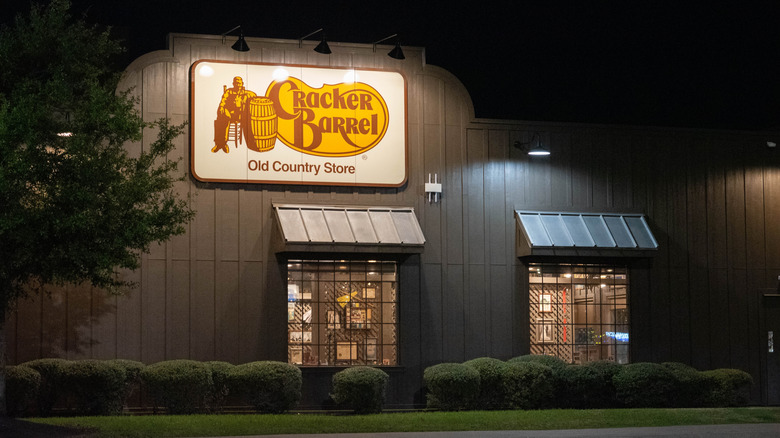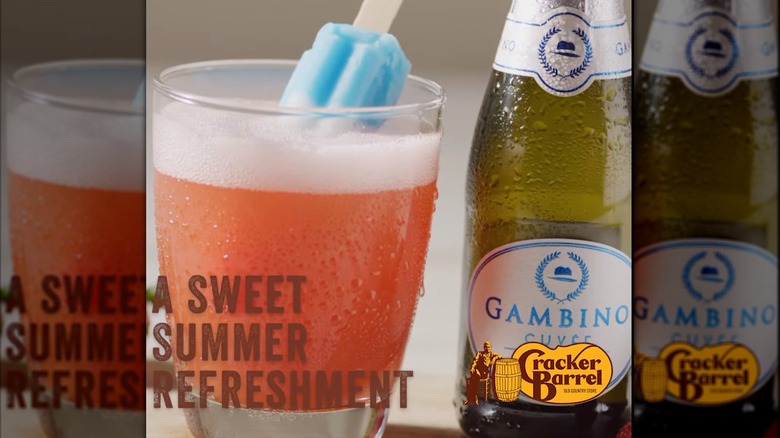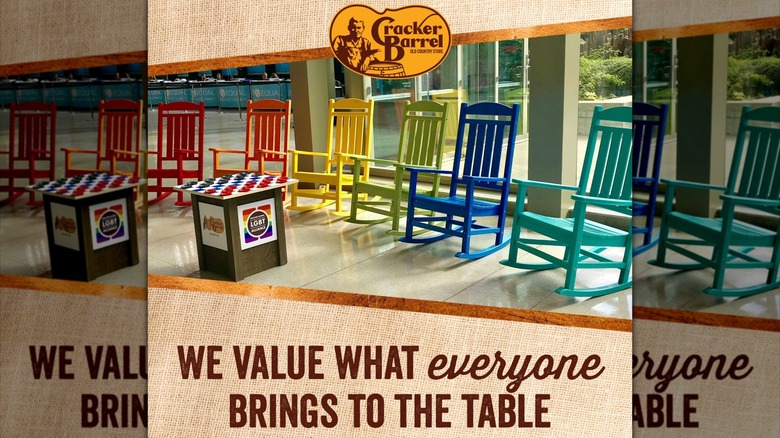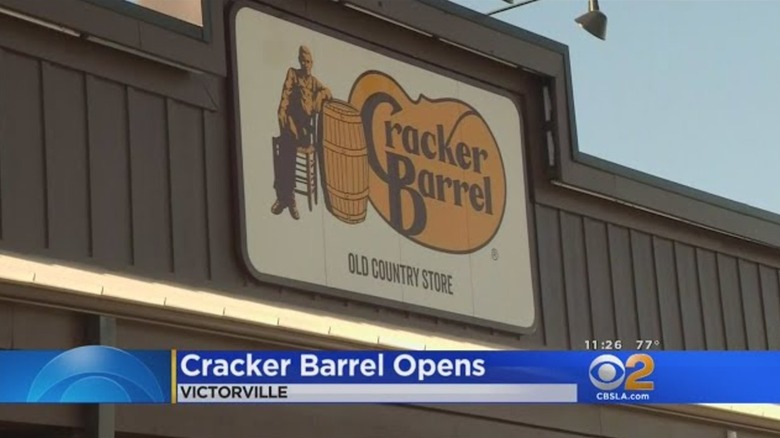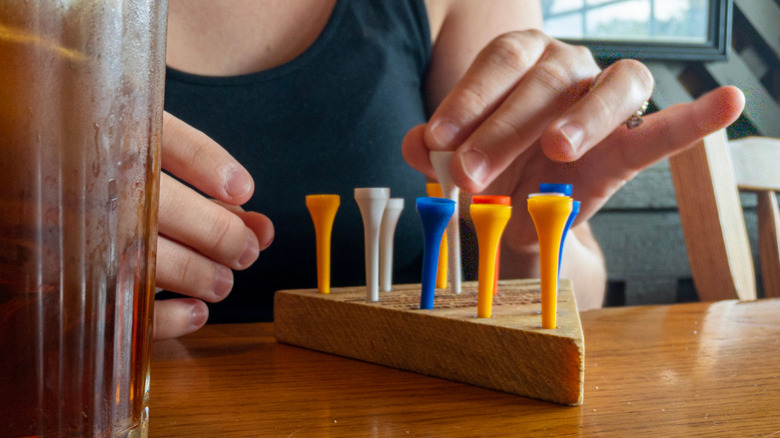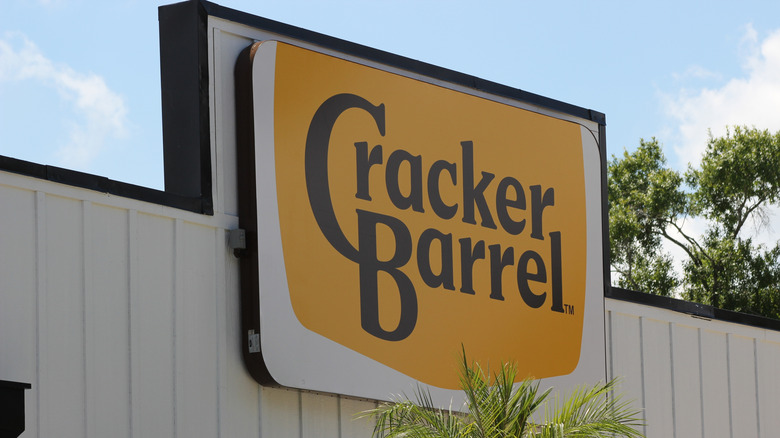The Biggest Changes In Cracker Barrel History
Few restaurant chains are as instantly recognizable as Cracker Barrel. For many, it is the epitome of roadside Americana: rocking chairs lined up on a wide wooden porch, a stone fireplace crackling in the colder months, and a gift shop stocked with checkerboards, vintage candies, and country-themed knickknacks that beg to be browsed while you wait for your table. However, it's also a brand weighed down by decades of missteps, tone-deaf corporate decisions, and a sometimes rocky relationship with the very communities it serves.
Founded in 1969 along an interstate in Tennessee, Cracker Barrel was built to capture the nostalgia of small-town general stores while catering to America's growing car culture. Over the decades, it's become a travel ritual for families crisscrossing the highways: pancakes the size of hubcaps in the morning, fried chicken for dinner, and maybe a jar of moon pies or a Dolly Parton CD from the shop on your way out. But behind that homespun image, the chain has often found itself in the middle of controversies and reinventions that reveal just how tricky it is to balance tradition with progress. As the chain enters a new chapter, it's worth looking back at the moments, both heartwarming and controversial, that have defined its journey.
Roadside roots and founding
The story of Cracker Barrel begins with Dan Evins, a Shell Oil salesman who opened the very first Cracker Barrel on September 19, 1969, in Lebanon, Tennessee, right off Interstate 40. From the outset, it was designed as a place where weary travelers could both fuel up and sit down for a country meal. The very name "Cracker Barrel" was chosen to evoke nostalgia for the old country stores where neighbors would gather around a literal barrel of crackers to chat.
According to Cracker Barrel's official history, the vision wasn't just about food, but creating a roadside destination that combined a sit-down restaurant with a retail element. The first store had rocking chairs out front, a stone fireplace, and a menu based on Southern staples. At the same time, the general store sold goods that tapped into people's yearning for Americana.
The concept resonated quickly, especially during a time when America's interstate highway system was expanding. Evins placed the first Cracker Barrel directly along a busy interstate exit to capture travelers, and this strategy would guide its growth for decades. By the end of the 1970s, there were multiple locations across Tennessee and neighboring states, all sticking to the roadside traveler-first model.
Brand DNA: gift shop and Americana decor
If you've ever sat down for chicken 'n' dumplings at any Cracker Barrel, you know the restaurant is about much more than food. It's also about the onsite general store. From its very first location, the brand leaned into retail, making it an integral part of the dining experience.
The store features a curated selection of Americana items, including toys, candy, apparel, and country-themed goods. Evins and his team worked with local antique experts to fill the walls with authentic relics of rural America, including license plates, old advertisements, farming tools, and musical instruments. Each location wasn't just a cookie-cutter copy but rather a carefully staged museum of Americana nostalgia.
This combination of food plus shopping proved to be a winning formula. Where else could you order meatloaf and cornbread, then walk out with a rocking chair or a jar of sorghum syrup? The retail operation grew so profitable that at times, it rivaled the dining side of the business. By the 1990s, Cracker Barrel's retail stores were so successful they became case studies in blending dining with shopping in the hospitality industry.
You entered through retail, ate in the restaurant, and then had to walk back out through the store, which meant you almost always grabbed a bag of candy or a quirky knickknack on the way out. Over time, those front porches lined with rocking chairs and checkerboards, plus interiors dripping in Americana memorabilia, became part of the brand's signature charm.
Gas pumps get the boot
Believe it or not, Cracker Barrel used to be as much about gas as it was about grits. The earliest locations weren't just restaurants with stores, but were fully functional gas stations. This revealed the smart business mind of founder Dan Evins, who worked in fuel distribution and already knew the ins and outs intimately, so placing a restaurant alongside gas pumps gave him an instant customer base.
Things were going well, but then the oil crisis of the 1970s changed everything. The 1973 OPEC oil embargo created nationwide shortages, skyrocketing gas prices, and long lines at the pump. Suddenly, operating fuel stations became less profitable and more complex. Cracker Barrel's leadership realized that the future of the brand wasn't in competing with Exxon or Shell but in leaning into what was already working: the restaurant and retail sides of the business.
By the mid-1970s, Cracker Barrel phased out its gas pumps entirely, making the pivot to being a food-and-retail-only chain. This was a crucial identity shift. It also freed the company to pursue rapid expansion beyond strictly highway fueling stops, since not every site would need a large fueling station.
Public offering sparks growth
Cracker Barrel's rise from a handful of roadside restaurants to a national powerhouse was fueled by the pivotal financial decision of going public. The company's initial public offering in 1981 provided the capital it needed to expand rapidly during the 1980s.
According to historical records, by 1987, Cracker Barrel's sales had reached $81 million, reflecting how quickly the brand was growing. Expansion during this period was aggressive, fueled by the IPO and a growing appetite for its unique combination of comfort food and country retail. Unlike competitors, Cracker Barrel wasn't just chasing highway exits, but was building a loyal customer base that sought it out for the distinctive experience.
The 1980s also marked the era when Cracker Barrel cemented its image with consistent design elements: the iconic front porch rocking chairs, the wooden checkerboard tables, and the fireplace as a focal point. This consistency made the brand instantly recognizable.
By 1992, just over a decade after the IPO, Cracker Barrel's valuation had topped $1 billion. That was an extraordinary feat for a company that had started just 23 years earlier as a small roadside stop in Tennessee. Going public gave Cracker Barrel the resources to grow beyond its Southern base and to compete on a national stage.
Experimenting with Corner Market
In the 1990s, Cracker Barrel decided to test how far its brand identity could stretch. The result was Corner Market, a short-lived concept that stripped out the restaurant and focused solely on retail.
These Corner Markets were meant to bring Cracker Barrel's general store charm to suburban areas without tying it to the roadside dining model. They carried many of the same items found in Cracker Barrel gift shops: toys, apparel, old-fashioned candies, and Americana-inspired goods. The hope was that customers who loved browsing the retail section on their way out of a meal would also patronize a standalone version.
However, the concept just didn't click. By the late 1990s, the experiment was discontinued, and Cracker Barrel returned to focusing exclusively on its hybrid restaurant-store model. It seemed that without the anchor of the restaurant experience, the retail side simply lacked the same magic. Part of what made Cracker Barrel's retail work was that it was woven into the dining journey, where guests entered through the store, ate, and then exited through it again, almost guaranteeing impulse purchases.
The failure of Corner Market taught Cracker Barrel an important lesson. For Cracker Barrel, the brand´s strength wasn't just in selling nostalgia-themed goods, but in curating an environment where shopping was a natural extension of eating.
Country music and Opry partnership
In 1994, Cracker Barrel expanded its cultural footprint by becoming the first-ever corporate sponsor of the Grand Ole Opry. This partnership was unprecedented, with a restaurant chain lending its name and brand power to one of country music's most iconic institutions.
Not only did Cracker Barrel attach its name to the Opry, but it also leaned hard into the connection between its down-home dining experience and country music heritage. Over time, the partnership expanded to include exclusive music releases available only in Cracker Barrel stores. Customers could pick up albums from Dolly Parton, Alan Jackson, Alabama, and other country stars while shopping the retail section.
This cemented Cracker Barrel not just as a restaurant chain, but as a cultural touchstone. The Opry partnership signaled that Cracker Barrel wasn't just selling nostalgia, but was actively helping shape and promote contemporary country culture.
By integrating music into its retail offerings, Cracker Barrel also differentiated itself from other chains. Buying an exclusive CD became as much a part of the visit as grabbing a bag of horehound candy or trying to beat the peg game.
Trademark tussle with Kraft
In 2013, Cracker Barrel ran into some legal trouble when Kraft Foods, the maker of "Cracker Barrel" cheese, which had been sold in supermarkets for decades, filed a lawsuit against the restaurant chain. The issue arose when Cracker Barrel announced plans to license its name for grocery-store packaged foods like hams, bacon, and other items. Kraft argued that this would cause confusion for shoppers, since the cheese brand had long used the Cracker Barrel name in retail.
The lawsuit was covered extensively in the press, with Kraft claiming it had exclusive rights to the Cracker Barrel name for grocery products and that the restaurant chain's entry into supermarkets would erode its brand. Ultimately, the two companies reached a compromise. Cracker Barrel could still sell packaged goods in supermarkets, but not under its full name. Instead, it created a new brand identity for retail: "CB Old Country Store." That allowed it to expand into grocery aisles while avoiding direct conflict with Kraft's established cheese products.
Cracker Barrel expands beyond the highway
For its first decade, Cracker Barrel lived and died by the interstate. Stores were almost exclusively located at highway exits, catering to road-trippers and truck drivers. By the late 1980s and into the 1990s, however, Cracker Barrel began a deliberate shift. The brand started moving into suburban areas, opening locations that weren't specifically tied to the highway system. This marked a significant transformation in how the chain positioned itself. Instead of being just a convenient pit stop, Cracker Barrel was now competing head-to-head with other casual dining restaurants in town centers and suburban hubs.
This change allowed the company to reach customers who loved the brand but didn't necessarily associate it with travel. Families could enjoy country cooking on a weeknight without needing to plan a road trip. It also diversified Cracker Barrel's customer base, ensuring that it wasn't overly dependent on seasonal travel or trucking traffic. At the same time, Cracker Barrel didn't abandon its roadside origin story. The interstate strategy continued, but it was now supplemented by a broader approach. This expansion was critical to the chain's rise from a regional novelty to a national sit-down powerhouse. The suburban expansion also demonstrated that Cracker Barrel's Americana branding wasn't limited to travelers. Its nostalgic appeal worked just as well for locals seeking comfort food and a sense of tradition.
Pandemic pivot to delivery and boozy brunch
Like every restaurant chain, Cracker Barrel faced existential challenges during the COVID-19 pandemic. Dine-in service evaporated overnight, forcing the company to adapt in ways that would have been unthinkable just months earlier. One major shift was delivery. In 2020, Cracker Barrel partnered with DoorDash, making its menu available for at-home orders for the first time. Comfort food like chicken and dumplings and biscuits suddenly became pandemic staples, delivered straight to people's doors.
At the same time, Cracker Barrel made a bold move into alcohol service. Historically, the chain had never served booze. It seemed to even take great pride in being a dry, family-friendly space. However, in 2020, it introduced beer, wine, and even mimosas to the menu. What started as a limited test quickly expanded into a broader rollout, as brunch cocktails proved popular with customers looking for a little more indulgence.
These shifts reflected the company's broader survival strategy: It couldn't just wait for normalcy to return. By embracing delivery and alcohol, Cracker Barrel reinvented itself for a new era. The pandemic forced it to shed decades-old taboos and lean into new revenue streams. While some traditionalists balked at the idea of alcohol at Cracker Barrel, seeing it as a betrayal of its wholesome image, the majority seemed to accept it, allowing the move to help keep the chain afloat and attract a younger, brunch-loving crowd.
LGBTQ hiring policy backlash
One of the darkest chapters in Cracker Barrel's history didn't involve food or branding at all. As reported by The Advocate, in 1991, Cracker Barrel adopted a company-wide policy that called for terminating employees who "fail to demonstrate normal heterosexual values." Several employees were fired as a result of the directive, sparking immediate backlash and boycotts from advocacy groups, labor unions, and concerned customers. The policy was rescinded within months, but the damage was already done. Cracker Barrel had become a poster child for discriminatory corporate practices.
Throughout the 1990s, the controversy lingered, showing up in protests and annual shareholder meetings where activist investors demanded policy changes. Cracker Barrel leadership resisted adding sexual orientation protections for over a decade. It wasn't until 2002 that the company formally added sexual orientation to its nondiscrimination policy. Later, executives sought to repair relationships with the LGBTQ community, including participation in advisory councils like the Human Rights Campaign's Business Advisory Council. Still, the early misstep left a permanent scar on the brand's reputation, a reminder of how cultural battles can derail even the coziest, most family-oriented restaurants. For many, it was a turning point in how Cracker Barrel was perceived. People viewed it less as a folksy highway stop and more like a flashpoint in the culture wars.
West coast expansion
For decades, Cracker Barrel was an exclusively Eastern and Midwestern phenomenon. Fans in California and the Pacific Northwest could only dream of hashbrown casserole and cornbread muffins. That changed in 2017, when the company opened its first-ever West Coast location in Tualatin, Oregon. The following year, Cracker Barrel doubled down with another location in Victorville, California, marking the brand's arrival in the Golden State. These openings were big news, with local papers covering the lines of customers eager to get a taste of a chain they'd only heard about from road trips back East.
The expansion was strategic. Oregon provided a foothold in the Pacific Northwest, while California offered access to one of the largest restaurant markets in the country. It was also a sign that Cracker Barrel was willing to test its nostalgic Southern identity far from its home base. While some doubted whether Californians would embrace Cracker Barrel's meatloaf, biscuits, and gravy-heavy menu, the openings were met with enthusiasm. Longtime fans flocked to the new stores, and social media lit up with pictures of the famous rocking chairs now sitting under West Coast skies. The move west demonstrated the chain's national ambitions. No longer just a roadside or regional brand, Cracker Barrel was planting its flag in markets where it had zero name recognition but plenty of curiosity.
Peg Game gets a refresh
If you've ever eaten at Cracker Barrel, you've probably spent a few minutes fiddling with the triangular wooden peg game that sits on every table. The rules are simple: Jump pegs until you can't, and try to avoid being left with more than one. It's a quirky touch that has become almost as iconic as the rocking chairs on the porch. However, in 2025, Cracker Barrel quietly updated the wording of the peg game's instructions. The old phrasing, which labeled players who performed poorly as "ignoramus," was softened to remove language some considered outdated or insensitive.
The change might seem small, but it tapped into a bigger debate about tradition versus modernity. For longtime fans, the game was a nostalgic staple of family road trips, the kind of low-tech diversion that made Cracker Barrel feel timeless. For others, the refresh was overdue, and revealed a company acknowledging that even small details can send big messages. Some customers praised the company for updating its language, while others grumbled that the tweak was yet another example of restaurants and companies going "woke" and adopting a politically correct agenda. Either way, the peg game's quiet update shows how even the smallest parts of the Cracker Barrel experience aren't immune to change.
All the More rebrand and logo drop
If there's one recent change that has stirred up a storm, it's Cracker Barrel's 2025 "All the More" rebrand. The company unveiled a $700 million transformation effort designed to modernize the chain and win back relevance with younger diners. The plan included refreshed interiors, streamlined menus, and expanded alcohol offerings, but the biggest shock came with the new logo. For the first time since 1977, the iconic "Old Timer" character leaning on a barrel was dropped. In its place: a minimalist, text-only logo reading simply "Cracker Barrel."
The reaction was swift, and brutal. Many customers felt the change stripped away the brand's homespun personality, with some conservative commentators accusing Cracker Barrel of abandoning its heritage to chase modern trends. Stock prices dipped in the immediate aftermath, reflecting investor anxiety over the risk of alienating a loyal customer base. Although executives defended the move as essential to keep Cracker Barrel competitive in a crowded casual dining market, they eventually buckled under the pressure to bring back the old classic logo, for now at least. The new campaign's slogan, "All the More," was pitched as a way of saying the company was giving guests more of what they loved, but clearly too many, including the POTUS, couldn't look past the loss of the old logo.
